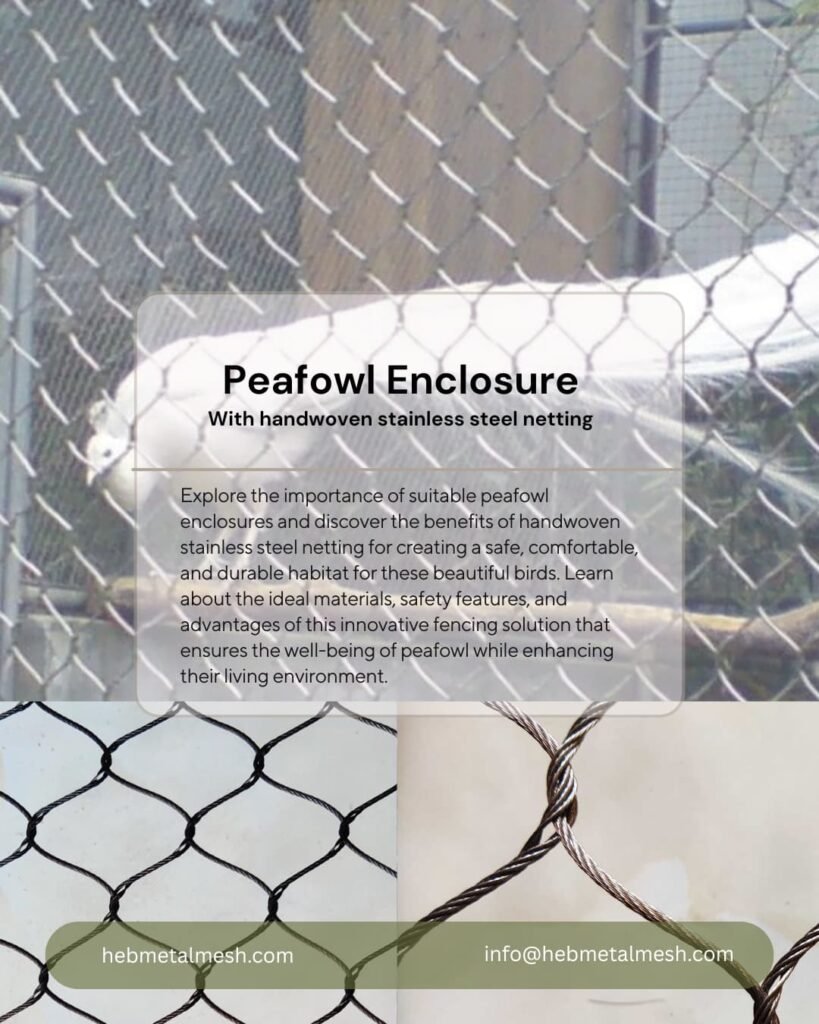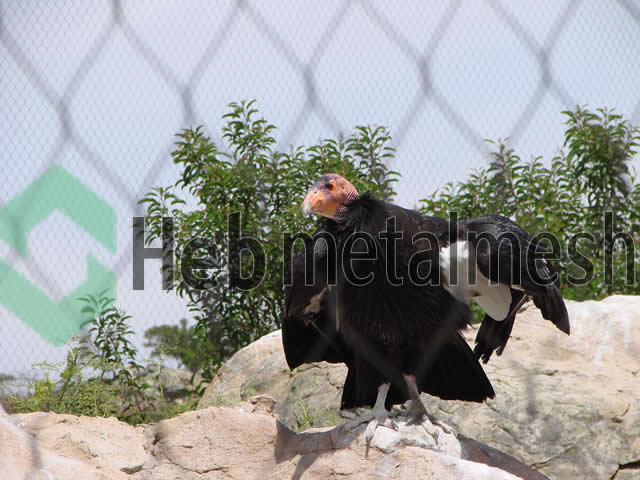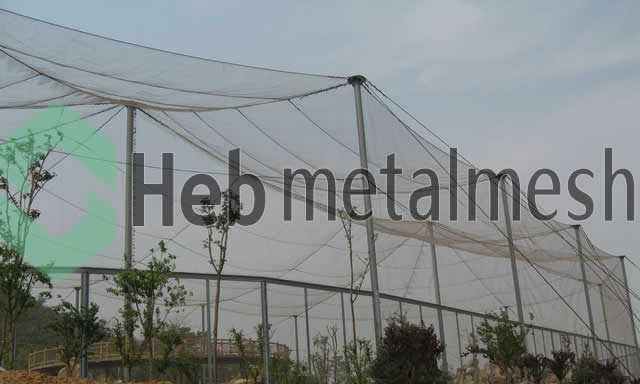Introduction to Peafowl Enclosures
Peafowl, known for their vibrant colors and impressive tail feathers, require suitable enclosures to thrive in a safe and controlled environment. A well-designed peafowl enclosure serves multiple purposes: it provides security against potential predators, offers a comfortable habitat for the birds, and allows for proper feeding and social interaction. The welfare of these magnificent birds is paramount, making the choice of enclosure critical for those who wish to keep them.
One of the essential aspects of establishing a peafowl enclosure is the selection of durable and effective fencing materials. As these birds are both curious and active, the enclosure must be designed to withstand their behavior while ensuring their safety. Stainless steel netting has emerged as an ideal option for peafowl enclosures due to its resilience and strength. This material is not only weather-resistant but also lightweight, making it easy to install while providing a secure environment for the birds.
The importance of a sturdy peafowl enclosure cannot be overstated. A well-constructed frame, combined with the right netting, minimizes the risk of escape and protects the birds from environmental hazards and predators. Additionally, the design of the enclosure can greatly enhance the overall habitat, providing ample space for the peafowl to roam and exhibit their natural behaviors. It creates an inviting environment that encourages healthy reproduction and interaction among the peafowl. By investing in high-quality materials like handwoven stainless steel netting, owners can significantly improve the living conditions for their birds, ensuring their safety and well-being.
Understanding the Ideal Material for Peafowl Habitats
When designing a peafowl enclosure, the choice of materials plays a critical role in ensuring the safety and well-being of these beautiful birds. Peafowls are known for their vibrant feathers and active behavior, which makes it essential to select materials that not only provide adequate protection but also enhance their living environment. One of the primary criteria to consider is strength. Peafowls are agile and can be quite adept at escaping enclosures, so it is crucial to use sturdy materials that can withstand their efforts and prevent any potential breakouts.
Longevity is another factor that cannot be overlooked when constructing a peafowl enclosure. Natural elements, such as weather, pest infestations, and wear and tear, can cause certain materials to deteriorate over time, leading to costly repairs or replacements. In the case of peafowl habitats, opting for durable materials such as handwoven stainless steel netting ensures that the structure remains intact for many years, allowing the birds to thrive in a safe and secure environment.
Safety is paramount in any habitat construction. Inadequate or improper materials may pose risks to both the peafowl and visitors. For instance, sharp edges or weak netting can lead to injuries or accidents. Therefore, selecting animal-friendly materials is essential. Handwoven stainless steel netting not only provides a robust barrier but also minimizes the chance of injury due to its fine mesh construction. Furthermore, this type of material is resistant to rust and corrosion, which is particularly important in outdoor settings where exposure to various elements is inevitable. In conclusion, investing in the right materials for peafowl enclosures is vital for the longevity, safety, and comfort of the birds and their surroundings.
The Advantages of Hebmetalmesh’s Handwoven Stainless Steel Netting
When it comes to constructing a peafowl enclosure, the choice of materials significantly impacts both functionality and longevity. Hebmetalmesh’s handwoven stainless steel netting stands out as a premier option in this regard. One of the primary benefits of these materials is their exceptional strength. Unlike traditional nets that may succumb to wear and tear over time, handwoven stainless steel netting is designed to withstand physical stress and resist damage from peafowl activities. Its robust construction ensures that the peafowl are securely contained, minimizing the risks posed by potential predators or environmental hazards.
Durability is another significant advantage of Hebmetalmesh’s offering. Crafted from high-quality stainless steel, this netting exhibits superior resistance to corrosion and rust, making it an ideal choice for outdoor enclosures subject to varying weather conditions. This longevity means that owners can experience a peace of mind knowing that their investment is protected against the elements. Furthermore, the handwoven design of the netting provides enhanced flexibility, allowing for easier installation and adaptation to different enclosure shapes and sizes.
Additionally, the resistance of this netting to ultraviolet rays is noteworthy, as it prevents degradation from sun exposure. This characteristic contributes to maintaining the visual appeal of the peafowl enclosure over time, ensuring that it remains a beautiful addition to any landscape. The aesthetic and functional benefits of Hebmetalmesh’s handwoven stainless steel netting make it a superior choice, outclassing more traditional materials that may not offer the same level of resilience.
In summary, the advantages of using Hebmetalmesh’s handwoven stainless steel netting for peafowl enclosures are clear. Its strength, durability, and resistance to environmental factors position it as an optimal material choice for both new constructions and renovations of existing enclosures.
Specifications of the 2″ x 2″ Mesh with 5/64″ Cable Diameter
The 2″ x 2″ mesh with a 5/64″ cable diameter is an essential feature of handwoven stainless steel netting designed specifically for peafowl enclosures. This configuration offers a balance of strength, durability, and safety, making it well-suited for keeping peafowls secure and comfortable within their habitat. The mesh’s size provides an optimal environment while preventing predators from accessing the enclosure.
One of the primary advantages of the 2″ x 2″ mesh specification is its structural integrity. The 5/64″ cable diameter is robust enough to withstand various environmental conditions while maintaining flexibility, which is particularly important in dynamic spaces where peafowls may engage in active behaviors. This durability is a significant consideration for anyone designing a peafowl enclosure, as it ensures longevity. The strong yet lightweight nature of stainless steel allows for easy installation and maintenance, reinforcing its practicality in outdoor and aviary setups.
Additionally, the spacing of the mesh promotes proper ventilation and sunlight exposure, crucial for the well-being of peafowls. Adequate air circulation is essential for the health of these birds, and the 2″ x 2″ mesh design facilitates this essential requirement. Operators can further enhance peafowl enclosures by incorporating vegetation and natural elements without compromising the enclosure’s integrity. This flexibility allows for customization that promotes a more natural environment for the birds while ensuring their safety through the robust mesh structure.
Ultimately, the 2″ x 2″ mesh combined with a 5/64″ cable diameter presents a reliable option for constructing peafowl enclosures that prioritize security and comfort. These specifications help create a safe and nurturing space for these beautiful birds, making it a preferred choice among aviculturists and hobbyists alike.
Safety Features of Stainless Steel Mesh for Peafowl
When it comes to creating an effective peafowl enclosure, one of the most crucial aspects to consider is the safety of the birds against potential threats. Stainless steel mesh has emerged as a preferred material for fencing due to its numerous protective qualities. This type of netting offers exceptional strength, which is essential in preventing predators from infiltrating the enclosure. Animals such as raccoons, foxes, and even birds of prey can pose a significant danger to peafowl, and a sturdy stainless steel mesh provides an effective barrier.
Another key safety feature of stainless steel mesh is its durability. Unlike other materials that may corrode or weaken over time, stainless steel is designed to withstand harsh weather conditions without compromising its integrity. This ensures that the peafowl enclosure remains secure for extended periods, reducing the likelihood of costly repairs or replacements. Additionally, the corrosion resistance of stainless steel helps maintain a hygienic environment for the birds, contributing to their overall health and well-being.
Stainless steel mesh is also designed with small openings that effectively prevent smaller animals from entering the enclosure, while still allowing for ventilation and visibility. This quality is particularly important as it ensures that peafowl can remain comfortable while being safeguarded from outside threats. Furthermore, the aesthetic appeal of stainless steel mesh contributes to a visually pleasing environment for both the birds and visitors, promoting an enjoyable experience in a safe setting.
In conclusion, the safety features inherent in stainless steel mesh make it an ideal choice for peafowl enclosures. Its combination of strength, durability, and protective qualities ensures that peafowl remain safe from predators while enhancing the overall design of the enclosure.
Flexible Roll Sizes: Cost-Effective Solutions
In the realm of constructing peafowl enclosures, flexibility and cost-efficiency play crucial roles. Hebmetalmesh offers a variety of flexible roll sizes in their handwoven stainless steel netting, allowing for tailored solutions that cater to a range of enclosure dimensions. This adaptability not only addresses the specific needs of different types of enclosures but also contributes significantly to reducing material waste during construction.
When selecting materials for any enclosure, particularly for peafowl, the size of the netting roll can greatly influence the overall cost and efficiency of the project. Standardized roll sizes may result in excess material or require additional cuts, ultimately leading to increased expenses and environmental waste. However, with Hebmetalmesh’s flexible roll sizes, builders can select the dimensions that most closely match their needs, minimizing off-cuts and optimizing the use of each roll. Such an approach ensures that every piece of netting contributes to the creation of the enclosure, providing a more sustainable building method.
Tailoring the roll sizes based on specific requirements not only makes construction more efficient but also enhances the overall aesthetic of the peafowl enclosure. Custom-sizing can lead to a cleaner finish with fewer seams or joints that may compromise the integrity of the structure. Ultimately, the ability to choose the right dimensions from a range of roll sizes allows for streamlined installation, saving both time and financial resources. As such, utilizing these flexible dimensions from Hebmetalmesh stands out as a smart choice for those looking to build robust and visually appealing peafowl enclosures.
Comparing Handwoven Stainless Steel Netting to Other Materials
When considering materials for a peafowl enclosure, it is essential to evaluate the various options available, particularly handwoven stainless steel netting, in comparison to more traditional materials such as wood, plastic mesh, and galvanized wire. Each of these materials presents distinct advantages and disadvantages that can significantly influence both the functionality and aesthetic appeal of the enclosure.
Wood, while offering a natural and visually pleasing appearance, is prone to deterioration over time due to weather exposure and pest infestations. The maintenance requirements for wooden structures are significantly higher, necessitating regular treatment to prevent decay and damage. Additionally, wooden enclosures can become unsafe if weight-bearing structures warp, creating potential hazards for the peafowl.
Plastic mesh is another common alternative; however, it poses its own set of challenges. While lightweight and easy to handle, plastic mesh is vulnerable to degradation from UV rays, leading to brittleness and eventual breakage. This fragility can compromise the safety of peafowl, as they may escape through damaged areas, and can result in additional replacement costs.
Galvanized wire, on the other hand, offers a sturdy option, providing good protection against predators. However, it lacks the aesthetic appeal of more visually pleasing materials and may rust over time if not properly coated. The rigid nature of wire also poses an injury risk to the birds, especially if they come into contact with sharp edges.
In contrast, handwoven stainless steel netting strikes an ideal balance between functionality and aesthetics. Not only is it highly durable and resistant to corrosion, but its flexibility allows for a variety of enclosure designs that can harmonize with the natural environment. The handwoven design also ensures that even small gaps are minimized, providing enhanced security for the birds while allowing for appropriate ventilation.
Overall, the comparative evaluation reveals that while alternative materials serve their purposes, handwoven stainless steel netting stands out as the superior choice for constructing peafowl enclosures, combining resilience, low maintenance, and an attractive appearance.
Testimonials and Case Studies
Handwoven stainless steel netting has proved to be a game changer for many customers who have implemented it in their peafowl enclosure projects. One noteworthy testimony comes from Sarah Thompson, an avian enthusiast who runs a small sanctuary for peafowl. According to Sarah, “Investing in Hebmetalmesh’s stainless steel netting has completely transformed the safety and aesthetic of my peafowl enclosure. Previously, I struggled with weaker netting that was susceptible to damage from wildlife. Since switching to this durable material, I no longer have concerns about predators harming my birds.” Her feedback emphasizes the resilience and effectiveness of the product.
Another customer, Mark Daniels, who operates a commercial peafowl farm, shared his experience: “The durability of the handwoven stainless steel netting is unmatched. It has withstood severe weather conditions and remains intact, providing a secure environment for my peafowl. The structural integrity of the enclosure has also improved significantly, which is essential for my breeding program.” This case aligns with the growing trend among farm owners to prioritize the safety and welfare of their birds while ensuring operational efficiency.
In a comparative case study, a local wildlife conservation group adopted Hebmetalmesh’s stainless steel netting for a large-scale peafowl enclosure in a natural habitat. They reported an overwhelming success in both the protection of the birds and their ability to thrive in a natural setting. The group noted that the visibility provided by the netting allowed for easy observation while ensuring that their peafowl were safe from potential threats. These testimonials and case studies collectively demonstrate not only the practicality but also the effectiveness of handwoven stainless steel netting in creating secure and long-lasting peafowl enclosures.
Conclusion: The Right Choice for Peafowl Enclosures
In addressing the needs of peafowl habitats, the selection of appropriate materials is paramount. Handwoven stainless steel netting emerges as a superior choice due to its unique benefits tailored specifically for peafowl enclosures. This advanced material not only boasts impressive durability and strength but also offers substantial resistance against environmental factors, ensuring the long-term security and safety of these beautiful birds.
One of the primary advantages of handwoven stainless steel netting is its resilience against wear and tear, making it an ideal option for outdoor setups. Unlike other materials, which may corrode or deteriorate over time, stainless steel maintains its integrity, providing a reliable barrier. This durability is essential when constructing peafowl enclosures, as it protects against not only the birds themselves but also potential predators that may pose a threat.
Moreover, the aesthetic qualities of handwoven stainless steel add to the appeal of any peafowl habitat. The open weave design allows for natural light penetration while still maintaining a secure environment. This transparency enhances the view of the peafowl, offering both a visually pleasing experience for caretakers and a stimulating environment for the birds. Additionally, the material’s non-toxic nature ensures that it does not pose any health risks to the peafowl, promoting a safe living space.
Ultimately, those researching options for constructing peafowl enclosures should seriously consider handwoven stainless steel netting. Its combination of strength, aesthetic appeal, and safety features makes it an unparalleled choice. Utilizing this innovative material will not only enhance the welfare of the birds but also contribute to a more enjoyable and practical peafowl habitat overall.


